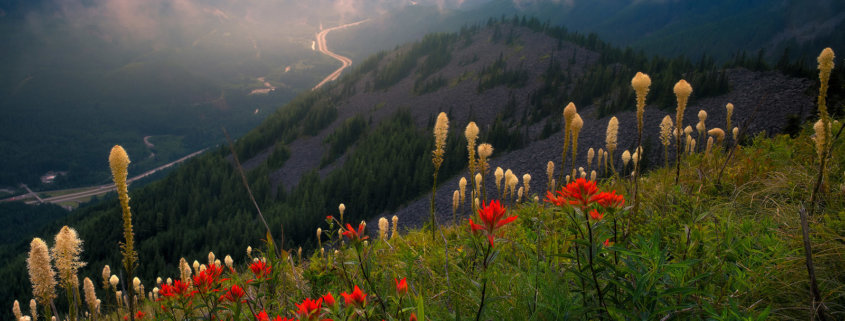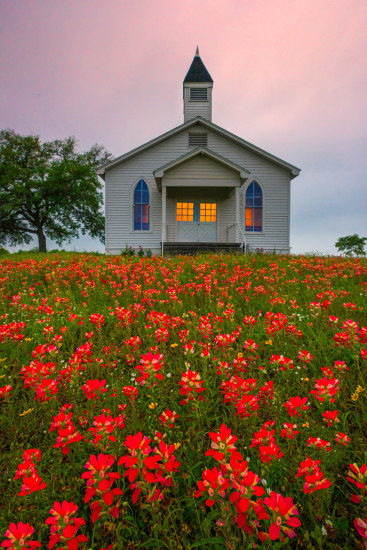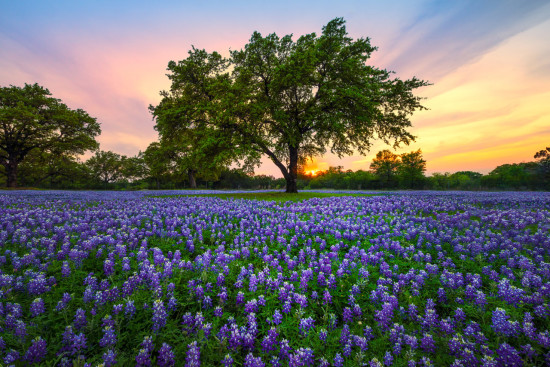7 Indispensable Tips for Photographing Wildflowers in Spring
My favorite time of the year for nature photography is always wildflower season. There are many reasons why it’s my favorite. Without a doubt the best reason is that we now have an excuse to get out into nature and explore. In the Pacific Northwest of the western states, you can find several different mountain ranges and regions that showcase incredible wildflower meadows. I must admit that it was the attraction of seeing amazing images from mountains like Mount Rainier and Mount St. Helens that drew me into photographing wildflowers in the first place.
I was specifically drawn into the vast amount of different colors in the wildflowers. The meadows burst with color and go on forever with no end in sight. At the end of the amazing display of spring wildflowers, the iconic mountain peaks stand tall. The combination of the wildflowers and larger-than-life mountain peaks drew me into the subject of spring wildflower photography.
Photographing wildflowers was how I started my nature photography career. Along the formative years of photographing wildflowers, I made a lot of mistakes. But slowly, with every new spring wildflower season, I learned from my mistakes and got a little better each year. Here are some important lessons that I learned over the years that will help you capture fantastic wildflower photos.
Research for Wildflower Seasons and Locations
Firstly, an important part of the process is doing the research. This entails using the internet, books, and apps that help you identify when and where the flowers are located. I begin this process by searching the internet to discover where wildflowers can be found. There are many books as well as websites that can be very specific about times and places. In addition, looking back at wildflowers in the last few years can be very helpful.
I also search the internet for wildflower forums and wildflower trip reports. Here is Washington we have an I organization called Washington Trails Association. It’s an active forum where like-minded people share information, images, and tips about a specific hike. Encompassed in the application and site are downloadable GPS tracks. The fluctuation of peak season for wildflowers varies quite a bit so make sure to combine your research from a variety of sources.
Another great source for finding wildflowers is by contacting your local ranger station. They can be a great resource for out-of-the-way locations that are harder to find.
When I combine multiple sources for research and check recent trip reports I end up being very successful with wildflowers.
Photography Equipment
The next step for achieving success with wildflower photography is to have the right equipment. You don’t need incredibly expensive equipment but there are a few important qualities that your camera and equipment should have.
Using a tripod is a part of the process and should be used at all times when photographing flowers. This allows you to be specific with your composition and the flexibility to frame as needed. Using a strong and sturdy tripod minimizes movement of the camera. One that is lighter and less solid can move during the picture-taking process. This causes a slight blur in the image that can’t be seen on the LCD in the field.
Cameras are improving at a fast rate and most cameras do a great job at producing quality images with little to no noise.
Photography Filters
Producing wildflower photos that contain good color rendition and vibrancy are vital to the overall goal. To make sure that you are able to reproduce these colors, you need a photography filter that can realistically take advantage of the bold colors and allow them to come through in the image. The filter I turn to for all of my wildflower images is the LB ColorCombo Polarizer. This filter offers two successful qualities in an image that boost impact.
The first is the color intensifier. Images taken with this filter consist of vibrant and bold colors. In many nature scenes this might not be vital but when photographing wildflowers, it’s critical. The second huge advantage of the LB ColorCombo filter is that it also contains a warming circular polarizer. In the past, it was necessary to stack filters to get these same results. This photography filter allows me to take advantage of the warmer tones in the photos (such as reds and yellows). It also renders the image with a natural color balance; what you see is what you get.
I have tried other photography filters in the past and found I was getting unusual color casts. Not only did I receive a color cast with other photography filters, but the colors were often muted. With the Singh-Ray LB ColorCombo, the results are excellent when it comes to reproducing accurate results.
Camera Lenses for Wildflower Photography
The choice of camera lenses used for photographing wildflowers is another important factor. Over the last 12 years of photographing wildflowers I have used several different camera lenses. Through experience I’ve found that lenses that are faster and wider make a big difference when it comes to the overall impact of the image. Because the weight of flowers can be very delicate, even the slightest wind can cause movement and reduce detail.
Having a lens that is fast – such is a 2.8 aperture – can increase your shutter speed and reduce the chance of blurred images. You can also combine this with a much faster ISO, which increases your shutter speed. Just be aware that increasing your ISO increases the overall noise in the image. It’s critical to find that balance of increasing the ISO but not high enough that it introduces too much noise. For my aperture I generally use f/13-f/16 unless the wind is very strong. In those situations, I shoot the foreground flowers at a higher aperture like f/8 and shoot another image for the background at f/16 and combine the two in post-processing. Use of this technique is used only if the wind is so strong that the higher ISO would introduce too much noise in the overall image.
Photography Composition to Capture Wildflowers
When it comes to the aesthetics of flowers, I use wide-angle lenses in the 11-24 mm range. This wide view allows more creative choices. Although this is a personal choice, I like to include as much of the foreground flowers as possible.
Using quality equipment and good lenses leads us into the next subject of composition. As with most areas of photography, composition is a critical part of successful imagery. Wildflower photography is a highly visual and expressive art. Because the elements and textures are so bold, it’s easy to include too much. Most beginning photographers try to include as much as possible when it comes to the elements. Because the display of wildflower meadows can be very busy and overwhelming, the final results can be chaotic and unorganized.
When considering the overall composition, it’s always better to include less and be more specific when it comes to the elements. Simplifying the composition goes a long way to creating an image that is cohesive and pleasing.
Color Harmony in Wildflowers Photos
When it comes to discussing the techniques of photography composition, one of the most important aspects is color harmony. Because wildflowers are very saturated by nature, too much color can be overwhelming and a distraction from the overall impact. Color harmony, if used in the right balance and amount, can enhance the overall mood of the image.
When shooting flowers, I try to think in terms of warm and cool tones. The color wheel is a great subject to research; use it as a reference and pay attention to your complementary colors. Frame the composition of the flowers so that the overall balance is not dominated by only warm or cool tones in any one region of the image.
Because each color has its own weight, having too much or not enough of that color on either side can pull the viewers eye. So the viewer gets stuck on one part of the image rather than flowing throughout the entire frame. For example, the lupine in Washington has a purple color and thus a cool tone. I then look to complement that cool color with a warmer tone flower such as Indian paintbrush, which is red. Having an image with a good mix of both of these flowers is far more visually aesthetic.
Light for Photographing Wildflowers
The use of lighting in your image can make or break and image. As with other subjects in photography lighting, whether it be natural or not, can bring your image to life. You can execute all the previously-mentioned tips to perfection but light is the one thing that is often overlooked when it comes to images that truly stand out. If light is used at the right time and direction it can bring attention to the main subject and interest of the image.
Many photographers are under the impression that it’s best to shoot flowers during the day when sunlight is at is strongest. The problem is that mid-day light leads to harsh contrast. Very dark shadows and hot highlights strip the color from the flowers and leads to a very unpleasing photograph. Its best to photograph flowers in the very last few moments of the day as the sun is near the horizon. The few moments of spotlight showcase the flowers in warm soft light that really draws the viewer’s attention. The sun is low enough on the horizon that the light has a soft, warm quality to it.
Another good time to photograph wildflowers is when the sun is not present. The wildflowers are cast in soft cool light and the even contrast of the light across the scene makes for pleasing color balance.
So make sure to be cognizant of the light and its direction. If used in the right way it can make all the difference in its overall impact.
Time to Get Out There and Enjoy Nature!
In summary, photographing wildflowers requires you to have the right equipment and camera lenses. Awareness of your camera settings and photography composition creates images that are full of detail and easier to process in Photoshop. Combining the following recommendations with the right light greatly increases the odds of capturing memorable wildflower photos. Lastly, remember to dress appropriately for the adventure. Bring lots of clothing layers, as the mountains can be unpredictable especially at night. Most of all have fun; you are seeing in nature at is best!

















